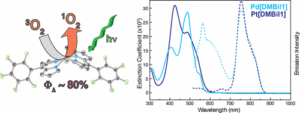Andrea M. Potocny, Allen J. Pistner, Glenn P. A. Yap, and Joel Rosenthal
Synopsis
The synthesis, electrochemistry, and photophysical characterization of a 10,10- dimethyl-5,15-bis(pentafluorophenyl)biladiene (DMBil1) linear tetrapyrrole supporting PdII or PtII centers is presented. Both of these nonmacrocyclic tetrapyrrole platforms are robust and easily prepared via modular routes. The Pd[DMBil1] and Pt[DMBil1] complexes adopt similar structures and both can undergo two discrete oxidation and reduction processes, as judged by cyclic voltammetry. Pd[DMBil1] and Pt[DMBil1] display triplet excited state properties, which are characterized by long wavelength emission and the ability to sensitize the formation of 1O2 with high quantum yields.
Abstract

The synthesis, electrochemistry, and photophysical characterization of a 10,10-dimethyl-5,15-bis(pentafluorophenyl)biladiene (DMBil1) linear tetrapyrrole supporting PdII or PtII centers is presented. Both of these nonmacrocyclic tetrapyrrole platforms are robust and easily prepared via modular routes. X-ray diffraction experiments reveal that the Pd[DMBil1] and Pt[DMBil1] complexes adopt similar structures and incorporate a single PdII and PtII center, respectively. Additionally, electrochemical experiments revealed that both Pd[DMBil1] and Pt[DMBil1] can undergo two discrete oxidation and reduction processes. Spectroscopic experiments carried out for Pd[DMBil1] and Pt[DMBil1] provide further understanding of the electronic structure of these systems. Both complexes strongly absorb light in the UV–visible region, especially in the 350–600 nm range. Both Pd[DMBil1] and Pt[DMBil1] are luminescent under a nitrogen atmosphere. Upon photoexcitation of Pd[DMBil1], two emission bands are observed; fluorescence is detected from ∼500–700 nm and phosphorescence from ∼700–875 nm. Photoexcitation of Pt[DMBil1] leads only to phosphorescence, presumably due to enhanced intersystem crossing imparted by the heavier PtII center. Phosphorescence from both complexes is quenched under air due to energy transfer from the excited triplet state to ground state oxygen. Accordingly, irradiation with light of λ ≥ 500 nm prompts Pd[DMBil1] and Pt[DMBil1] to photosensitize the generation of 1O2 (singlet oxygen) with impressive quantum yields of 80% and 78%, respectively. The synthetic accessibility of these complexes coupled with their ability to efficiently photosensitize 1O2 may make them attractive platforms for development of new agents for photodynamic therapy.





